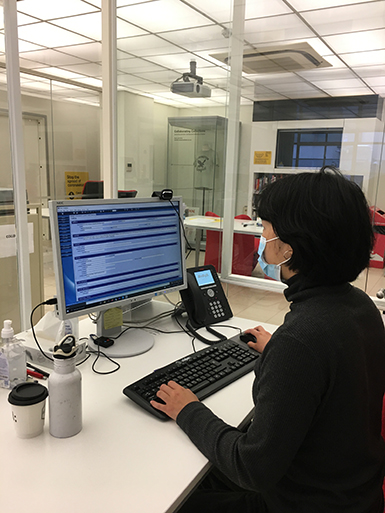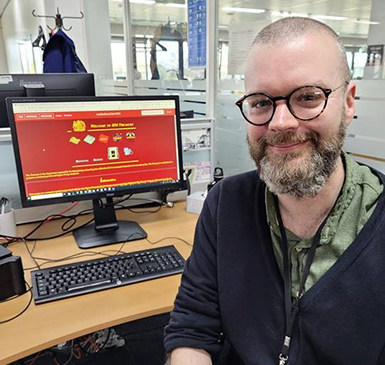Over the past four years, The National Archives’ Bridging the Digital Gap programme has created 24 technical traineeships that brought new talent with much-needed technological skills into the archive sector. Supported by the National Lottery Heritage Fund, the programme placed trainees in archives across England on a 15-month secondment. The second cohort of trainees finished in December 2020. This month, we caught up with three of them to find out how their traineeships helped them in their new careers.

‘Having worked in digital humanities but being new to archives, I found the traineeship was the perfect entry point to a career in the archive sector,’ Marco Brunello says. ‘Even though the Bridging the Digital Gap programme focused on digital skills, it still provided me with a comprehensive overview of working in archives. This has been extremely useful in my role as an Archive Assistant at the West Yorkshire Archive Service (WYAS), which has required knowledge of the archive field beyond digital preservation.’
‘I was particularly lucky as my traineeship involved two institutions – the University of Leeds Special Collections and Northern Ballet. This allowed me to experience two different types of archives – special collections and a business archive. I was able to contribute to both: taking part in the everyday duties, and exchanging ideas on how to handle various situations, especially involving digital collections.’
‘Over a year later, my work is still having an impact at the University of Leeds. One of my main technical projects was to create an efficient way to automatically extract metadata from a large collection of born-digital files and add it to catalogue records. This process has proven so useful that it is still in use and has been repurposed for other projects.’
At WYAS, Marco works with a diverse collection, from the West Riding Registry of Deeds to mental health and parish records. Recently, the service has been expanding its digital work. ‘WYAS has acquired Preservica, a digital preservation system,’ Marco explains, ‘and our searchroom now has a dedicated space for on site access to digitised and born-digital records that cannot legally be made available online. I have been appointed Digital Preservation Archive Assistant, two days a week, and in this new role I can apply my technological skills and knowledge.’
‘Overall, the traineeship was an extremely worthwhile experience as it allowed me to start a career in a rewarding field that I am very passionate about and where I feel my skills are put to a good use.’

Erin Liu did her traineeship at the University Archives and Special Collections Centre at University of the Arts London (UAL). She is now an Assistant Archivist there.
‘The traineeship prepared me to work with others across a large organisation,’ Erin says. ‘As the Bridging the Digital Gap trainee, I supported the Digital Archives and Collections Project. This brought together a range of collections management, IT, and project management staff to implement a digital preservation system and develop its bespoke user interface. Being involved in this cross-departmental project has helped me in my current role, where I work closely with colleagues – archivists, curators and a digital preservation specialist – to plan how to manage and provide access to the collections.’
‘After the traineeship and before taking up my job at UAL, I worked two short-term contracts in digital scholarship and digital preservation at other universities. Working adjacent to both archives and libraries in these roles, I realised that digital preservation benefits from a solid understanding of practices across all the information sectors, including galleries and museums.’
‘Now, as an Assistant Archivist, I support the everyday operations of the archive centre, which has fascinating collections related to design, printing, graphic art and film-making, such as the Stanley Kubrick Archive. In addition, I have been developing and delivering teaching sessions, which help students from across UAL’s six colleges to use archives within and beyond the university. These hands-on sessions introduce them to archival research and concepts in critical archival studies. They also provide opportunities for students to engage with historical materials through their creative practice as artists.’
‘The traineeship prepared me for delivering these sessions. In a group project, I worked with three other trainees to design and deliver a series of online workshops about personal digital archiving, aimed at non-specialists. The Digital Preservation Coalition’s website hosts the resources we produced.’

During his traineeship at the University of Westminster Archive, Jacob Bickford became interested in web archiving. He is now a Web Archiving Assistant here at The National Archives.
‘I had lived and worked with digital files for most of my life,’ Jacob says, ‘but I’d never thought deeply about what they fundamentally consist of. During my traineeship, I read Trevor Owens’ book ‘The Theory and Craft of Digital Preservation’, and it blew my mind! The book introduced me to the idea that digital ‘objects’ are made up of many different layers beyond what we see on the screen. All of these components provide us with different insights into the record and pose different preservation challenges.’
‘I was also introduced to the National Archives of Australia’s Performance Model of digital records, which uses the analogy of a theatrical performance. The file is like the script, the software the actors, and the hardware the stage. They work together to “perform” the file to present it to the viewer. Any changes to the underlying components result in a different experience for the user. These ideas really changed how I looked at digital files. I became much more interested in what was going on “behind the scenes” and how it could be made available to researchers.’
‘Without my traineeship, I would have only had a vague awareness of web archiving. During the pandemic, we were conscious of how quickly information provided to students on the University of Westminster’s website was updated and overwritten. I learned how to capture our COVID-19 information pages on a daily basis using Web Recorder, a free web-archiving solution. I went on to capture other sites as part of the university’s web archiving programme to record how they also changed over time.’
Jacob is enthusiastic about the possibilities of digital archives. ‘Born-digital and digitised records enable new forms of access,’ he says. ‘Projects like the GLAM Workbench and Archives Unleashed have created tools that enable researchers to access material at a far larger scale than was possible in the past. For example, we might calculate how frequently particular terms appear in a vast set of records over time, or find unexpected patterns in a large collection of texts. I have had a chance to experiment with some of these techniques, which gave me a sense of the huge possibilities. Given the enormous – and expanding – size of the web archive and our other digital holdings, The National Archives and the wider sector have been at the forefront of exploring these techniques. At the UK Government Web Archive, we are keen to build on this work to do more to facilitate this kind of access for researchers.’
‘I love how engagement with the past is really an ongoing series of interpretations and arguments in dialogue with the records. It might be tempting to think that digital records are somehow more fixed and “objective” than conventional records, but that is not really the case. As well as reflecting the perspective of their creators, records are always affected by the archival process: how they have been arranged and described in a conventional archive, or by the choice and configuration of the capture software used for the web archive. That is not to say that archives are unreliable. Just that, like all historical sources, they need to be read critically and with as much awareness as possible of the way in which they were created and how they have been preserved. Digital archives are no exception.’
Marco, Erin, and Jacob are among several Bridging the Digital Gap trainees who are now employed in the sector. The others are working at Aberdeen University Museums and Special Collections, British Library, British Film Institute, East Riding Archives, Portland Museum, South West Heritage Trust, and the University of Bristol’s Special Collections and Theatre Collection.